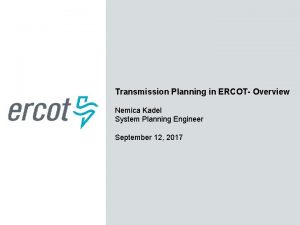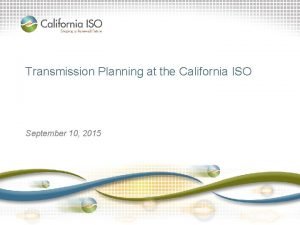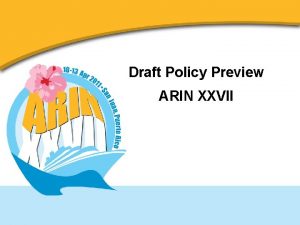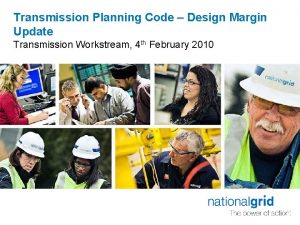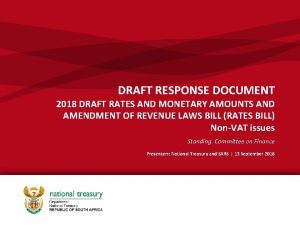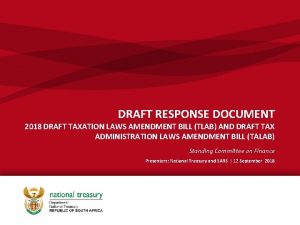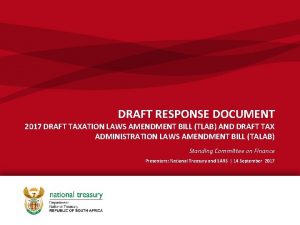Transmission Planning Code Draft Document Transmission Planning Code











- Slides: 11

Transmission Planning Code – Draft Document Transmission Planning Code Workshop 4 3 rd July 2008

Introduction ® National Grid Gas (NGG) has a new licence obligation to introduce a Transmission Planning Code by 1 October 2008 that will “cover all material technical aspects relating to the planning and development of the pipe-line system…which may have a material impact upon persons connected to or using (or intending to connect or to use) the pipe-line system” ® Aim is to improve transparency of NTS planning process ® NGG must comply with and maintain the code, reviewing it at least every two years ® Review cycle will include consultation with interested parties

Transmission Planning Code – What is it? ® Framework document relating to the planning and development of the NTS ® Methodology to determine the physical capability of NTS considering ® Entry and exit capacity release obligations ® How much capacity can be transferred/traded between entry points ® How incremental flows at entry and exit affect system capability ® Statutory network security obligations ® Detailed assumptions on ® How supply and demand patterns will develop over time ® How the system will be operated under different supply and demand scenarios

The story so far. . . ® Open Letter on Draft Scope published 7 March 2008 ® 4 non-confidential responses received from E. ON, Centrica Energy, RWE npower, Scotia Gas Networks ® 3 workshops held between April and June ® Topics covered include Supply and Demand Scenarios, Flow Margin, Entry and Exit Processes ® Draft TPC document circulated for comment ahead of formal consultation ® Discussions have confirmed the need for a high level framework document, in summary: ® Commercially sensitive data will not be published ® “Code of practice” for planning and developing the NTS ® Stable framework to be established for investment decision-making ® Duplication of other methodologies to be avoided ® Link between TBE forecasts, entry/exit commercial processes and investment planning should be clear

Timeline (2008) March April May June Development 7 March Open letter inviting views on scope by 21 March 2008 April-July Industry discussions on draft document July Aug Sept Oct Nov. . . Implementation July Aug/Sept Formal Authority consultation considers (28 days) consultation report workshop 3 July Consultation planned 1 October 2008 target date for from w/c 7 July implementation

Content of TPC (1) “The transmission planning code shall cover all material technical aspects relating to the planning and development of the pipe-line system to which this licence relates, which may have a material impact upon persons connected to or using (or intending to connect to or use) the pipe-line system to which this licence relates, ” Chapter 2: Legislative framework ® Gas Act and Licence ® Pipeline Safety Regulations ® Pressure Systems Safety Regulations ® Gas Safety (Management) Regulations ® EIA Directive ® Town and Country Planning Act ® IPPC Directive ® EU ETS Directive ®Chapter 3: Policy and guidelines ® Relevant IGEM guidelines ® National Grid planning policy

Content of TPC (2) “and shall include: (a) a methodology to determine the physical capability of the pipeline system to which this licence relates. . . ” ® Chapters 5 and 6: Supply and Demand ® Physical capability is dependent on supply/demand assumptions used ® Chapter 4: Investment Planning ® Network capability analysis and investment planning analysis ® Chapter 9: Network Analysis ® Network analysis assumptions

Content of TPC (3) ® ® Influence of QSEC, IECR and capacity substitution on plan ® T&T undertaken in operational timescales ® IECR and Entry Capacity Substitution Methodologies contain detail “. . . specifying in detail how the licensee is taking into account: (i) its entry capacity release obligations. . . and its exit capacity release obligations. . . ; (ii) the amount of capacity that may technically be transferred or traded between NTS entry points; Chapter 7: Entry Capacity ® Chapter 8: Exit Capacity ® Transitional period only ® Interaction of OCS and load enquiry data with plan ® Ex. CR contains detail ® Chapter 4: Investment Planning ® Physical model results compared against commercial obligations

Content of TPC (4) “ (iii) the impact of incremental gas flows upon the capability of the pipeline system to which this licence relates at each NTS entry point and NTS exit point; and (iv) statutory network security standards. ” ® Chapter 4: Investment Planning ® Planning cycle, network capability and investment planning ® Chapter 9: Network Analysis ® Network analysis assumptions ® 1 -in-20 peak as in S. Sp. C. A 9 ® also GSMR requirement for adequate pressure for gas leaving the NTS

Content of TPC (5) “(b) the detailed assumptions that the licensee is using in respect of: ® ® Scenario based approach ® TYS, Demand Forecasting Methodology contain details (i) the likely developments in the patterns of the supply of gas and the demand for gas; (ii) the likely developments in the levels of the supply of gas and the demand for gas; and (iii) the likely operation of the pipe-line system to which this licence relates for any given pattern and/or level of supply of gas or demand for gas. ” Chapters 5 and 6: Supply and Demand ® Chapter 9: Network Analysis ® Use of network analysis models for relevant gas year and supply/demand scenarios ® Network analysis assumptions

Summary ® Draft Transmission Planning Code has been developed through discussions with industry ® Aim is to describe high level framework surrounding planning and development of the NTS ® Balances requirements for transparency and data confidentiality ® Periodic reviews will be undertaken to ensure the document is maintained in line with legislative, commercial and planning policy changes ® 28 -day formal consultation planned from w/c 7 July ® Consultation report submitted to Ofgem late August ® Authority decision on document during September ® Implementation from 1 October 2008, subject to consultation responses and Authority approval



